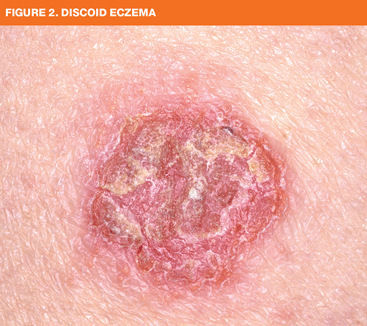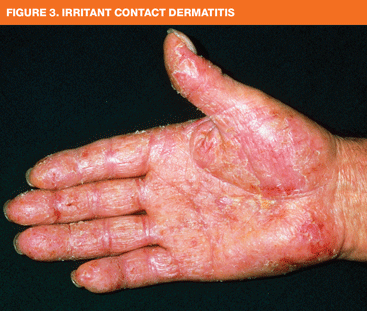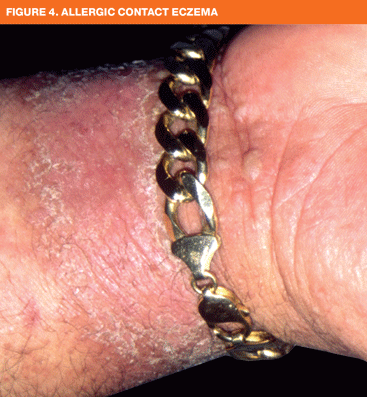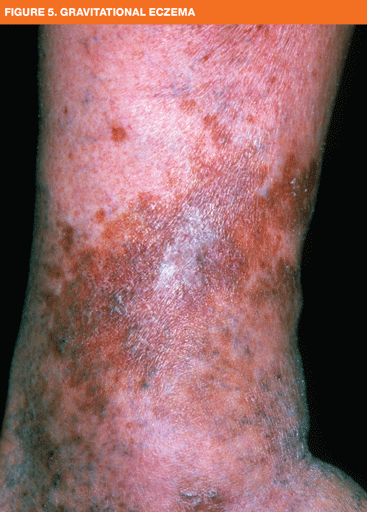Eczematous conditions in older skin
Sandra Lawton
Sandra Lawton
OBE,MSc,RN,OND,RN Diploma (Child) ENB 393, QN
Nurse consultant dermatologist, Nottingham University Hospitals NHS Trust
Skin ageing is a continuous process that affects not only the appearance of the skin but its function, and which also increases the possibility of developing eczema. Here we look at some of the most common types to affect our elderly patients
As we get older our skin undergoes a number of changes. Major skin changes are one of the many features occurring with ageing and it is estimated that 70% of elderly people have skin problems.1 Skin ageing is a continuous process that affects the function of the skin and its appearance, and increases the possibility of developing a skin condition. There are intrinsic changes that affect the structure and function of the skin, resulting in dryness, atrophy, laxity, wrinkles, sparse grey hair and pigment changes. External factors also contribute to skin ageing. These include the cumulative effects of exposure to a variety of environmental pollutants, ultraviolet light and smoking, as well as changes to our environment and lifestyles such as more leisure time and exposure to potential irritants and sensitisers (the weather, central heating, soaps and detergents); general health issues and medications also play an important part.2
SKIN CONDITIONS IN OLDER PEOPLE
Many skin conditions may affect us in advancing years,3 but this article will focus on eczematous conditions. For many people, dryness and pruritus (itch) are the major symptoms. Persistent severe pruritus (more like pain), can dominate daily life, causing sleepless nights and exhaustion, impacting on all activities and relationships.4
Anyone with pruritus should have their full medical history taken and be assessed to identify any skin conditions or other health problems that may cause the itch. This includes examination of the skin to look for any rashes or lesions, a general physical examination and questions relating to weight loss, fatigue, fever, malaise, recent emotional stress and medication history. If the itching is persistent and there is no immediately obvious reason for it, blood tests and a chest X-ray may be required.
Other causes of pruritus include:
- Metabolic and endocrine conditions
- Haematological disease
- Malignant neoplasms
- Liver disease
- Prescription drugs, and
- Psychological causes.4
ASTEATOTIC ECZEMA
Asteatotic eczema (Figure 1) is associated with very dry skin and occurs most commonly in people over the age of 60. Living in dry, heated rooms, exposure to winter weather or excessive bathing or showering, increase the risk of developing this type of eczema. It most often affects the shins, but sometimes involves other areas such as the thighs, arms, abdomen and back. The affected skin becomes rough and scaly and may show a criss-cross pattern of cracks that look like crazy-paving or a dried-up river bed. The cracks only affect the very top layers of the skin but can be very red, sore or itchy. It is uncommon to see blistering and thickening of the skin in this type of eczema.5
DISCOID ECZEMA
Discoid eczema (Figure 2) is a less common type of eczema that develops as round patches of scaly skin about the size of a 50-pence piece or smaller. These patches can occur anywhere on the body but will most often affect the lower legs or arms. The skin is itchy, red and bumpy, and can become very inflamed with oozing and crusting, especially if the eczema becomes infected. As the eczema clears, the patches become dry and scaly.
Anyone can get discoid eczema but it is most common in older children and adults who have very dry skin. The patches will clear up with treatment (emollients, topical steroids, oral antihistamines and antibiotics if infected) but over time the same patches of eczema can flare up again and again, or new patches can develop. This can continue for months or sometimes years.5
CONTACT DERMATITIS
Contact dermatitis is caused by substances coming into contact with the skin. Many different substances can cause contact dermatitis, including common ones found in the home or work environment. Contact dermatitis can be divided into two types – irritant and allergic. Telling the difference between the two types is based on the history and distribution of the rash as both can look very similar and coexist. Patch testing is used to determine an allergic cause.
Irritant contact dermatitis
Irritant contact dermatitis (Figure 3) is very common and affects all age groups, accounting for over three-quarters of cases of contact dermatitis. It occurs as a direct result of physical damage to the skin by substances such as soaps, detergents, solvents and diluted acids or alkalis. These substances can irritate the skin without actually causing an allergic reaction. Irritant contact dermatitis is most likely to affect the hands, especially around the finger webs where the skin is delicate and prone to damage. Skin changes range from mild dryness to severe redness, cracking and blistering. Irritant contact dermatitis is the most common cause of occupational skin disease, and particularly tends to affect people doing occupations involving wet work, such as catering, hairdressing, cleaning and nursing, as well as those who do housework or care for young children.
Patients with a history of atopy are more prone to developing irritant contact dermatitis as their skin is more sensitive and vulnerable to damage.5 In older patients with urinary or faecal incontinence, irritant contact dermatitis can also affect the buttocks and genital area (incontinence-associated dermatitis). Prolonged contact of urine or faeces with the skin typically presents as inflammation of the skin surface, characterised by redness and, in some cases, swelling and blister formation.6
Allergic contact dermatitis
Allergic contact dermatitis (Figure 4) is much less common than irritant contact dermatitis, accounting for around one-fifth of cases of contact dermatitis overall. It occurs when the individual becomes allergic to a substance coming into contact with his or her skin. The most common substances to cause allergic contact dermatitis include:
- Nickel (in some jewellery)
- Fragrances (in perfumes and toiletries)
- Preservatives (in creams and ointments)
- Antibiotic creams
- Hair dyes
- Rubber (in gloves, balloons and condoms)
- Chromate (in leather and cement), and
- Plants
People often think that they cannot become allergic to something they have been using for a long time, but this isn’t true. Allergic contact dermatitis can develop after months or years of exposure with no previous problems. It occurs when the body’s immune system starts reacting against a substance and develops antibodies to it, so that every time the individual comes into contact with it again he or she will develop eczema. Allergic contact dermatitis is often seen on the hands but can affect any area of skin. The distribution of the eczema often gives a clue to the cause as it usually occurs only where the substance has been in contact with the skin.
Occasionally, contact dermatitis can spread to other parts of the body that haven’t been in direct contact with the substance. The skin changes can range from mild redness and scaling to severe inflammation with weeping, cracking and blistering. The affected skin is usually very itchy and sore.5
GRAVITATIONAL ECZEMA
Gravitational eczema (Figure 5) is a common type of eczema related to increased pressure in the veins of the legs. It commonly affects in adults who have varicose veins, or who have a history of leg ulcers or deep vein thrombosis (DVT). However, it is possible to develop increased pressure in the leg veins without ever having had varicose veins, leg ulcers or DVT. Other risk factors include being overweight or obese, and spending a lot of time standing up. Gravitational eczema is more common in women than men because female hormones and pregnancy both increase the risk of developing the condition. With increasing age, return circulation becomes less efficient at returning blood to the heart, and valves can become incompetent. There may be oedema and changes in skin colour as a result (orange-brown macular pigmentation due to haemosiderin deposition) and other signs of venous insufficiency: atrophie blanche (white irregular scars surrounded by red spots) and ‘Champagne bottle’ shape of lower leg (narrowing at the ankles) and induration (lipodermatosclerosis).7 The skin becomes shiny, red, itchy and flaky, and may also ooze, weep and crust which could be a sign of infection or possible irritant/allergic dermatitis. Over time the skin can become very thickened and leathery.
Gravitational eczema is usually restricted to the lower legs, but occasionally the eczema can spread to involve the whole leg or become even more widespread. This is most likely to occur if gravitational eczema is severe and not being managed with appropriate topical treatments, elevation and compression.
Compression hosiery can be useful, and patients should be encouraged to take regular walks, elevate their feet when sitting and to avoid standing for long periods. If the lower legs are swollen, they should be raised above the level of the hips in order to drain them effectively, and should be elevated in bed overnight.7 For some people, losing weight will help to reduce the pressure in their leg veins, and for those with confirmed venous insufficiency, surgery to remove or repair veins with incompetent valves.
Eczema and leg ulcers
Increased pressure in the leg veins is one of the most common causes of leg ulcers, and patients with gravitational eczema are at an increased risk of developing leg ulcers, particularly in the damaged areas of skin. Ulcers usually start after minor trauma, such as scratching the eczema, so extra care is needed. Leg ulcers can be very slow to heal because of the sluggish blood flow to and from the skin. Sometimes a leg ulcer will develop before the gravitational eczema appears, in which case the eczema usually develops as patches of itchy, red, flaky skin around the edge of the ulcer.
It is important to remember that allergic and irritant contact dermatitis are also possible causes of lower leg eczema in people with leg ulcers, and can look similar to gravitational eczema. If the wound is very wet, this can irritate the surrounding skin and cause an irritant eczema. Common causes of allergic contact dermatitis in the lower legs include creams, dressings and bandages, and patch testing will be required to identify what is causing the problem.5
CONCLUSION
Skin disease can significantly affect patients’ quality of life at any age. They may worry that their condition is infectious or feel embarrassed and reluctant to seek help. However, they should be advised not to self-treat as some products may make things worse rather than better. All the conditions described here can be managed with simple measures and interventions, including correcting the underlying cause if known and the regular use of emollients and topical corticosteroids for flares.
This article has been adapted with the permission of the National Eczema Society from an article that first appeared in the Society’s quarterly magazine Exchange (June 2014).
REFERENCES
1. All Party Parliamentary Group on Skin. Report on the Enquiry into Skin Diseases in Elderly People, 2000. APPGS, London. http://www.appgs.co.uk/wp-content/uploads/2012/07/SKIN-DISEASES-IN-ELDERLY-PEOPLE-2000.pdf
2. Lawton S. Addressing the skin-care needs of the older person. British Journal of Community Nursing 2007;12(5):203–210
3. Norman RA. Geriatric dermatology. Dermatologic Therapy 2003;16(3):260–68
4. Fitzpatrick TB, Johnson RA, Wolff K & Suurmond D. Color Atlas & Synopsis of Clinical Dermatology. New York; McGraw-Hill:2011
5. Charman C, Lawton S. Eczema: The treatments and therapies that really work. London; Constable Robinson: 2006
6. Voegeli D. Moisture-associated skin damage: aetiology, prevention and treatment. British Journal of Nursing 2012;21(9):517–21
7. DermNetNZ. Venous Eczema, 2014. www.dermnetnz.org/dermatitis/venous-eczema.html
Related articles
View all Articles




